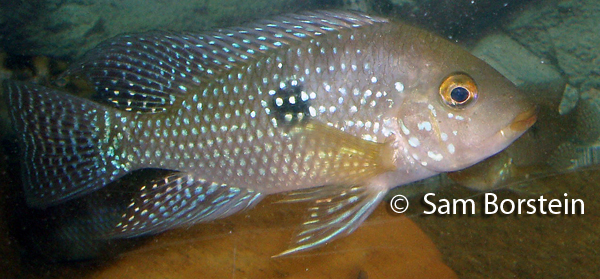'Geophagus' iporangensis
Haseman 1911
Synonyms: Geophagus brasiliensis iporangensis

Above: A male 'Geophagus' iporangensis. Photo by Sam Borstein.
Etymology:
Genus- Geos= Earth (Greek), Phagein= Eat (Greek)
Species- iporangensis= Named after the Brazilian city Iporango, the type locality.
Intro:
'Geophagus' iporangensis is a beautiful eartheater from Brazil and a rather new fish to the hobby. Originally, this fish was described as a subspecies of 'Geophagus' brasiliensis. The two fish are extremely similar and one could see why they were originally described as a subspecies. 'Geophagus' iporangensis differs from 'Geophagus' brasiliensis in that it has a more elongate and less deep body form, grows smaller, has less spangling on the operculum and fins, and has a strong red hue to the unpaired fins. Like 'Geophagus' brasiliensis, 'Geophagus' iporangensis is very colorful and is unproblematic to keep.
The Geophagines are split up into complexes. The 'Geophagus' crassilabrus and 'Geophagus' brasiliensis complexes are awaiting desriptions for new genera.
- Geophagus- Contains species like the Geophagus altifrons, and Geophagus proximus
- 'Geophagus' crassilabrus complex- These are all the immediate mouthbrooding Geophagus like 'Geophagus' steindachneri.
- 'Geophagus' brasiliensis complex- All the Pearlscale Eartheaters like 'Geophagus' brasiliensis and 'Geophagus' iporangensis.
You will commonly see 'Geophagus' written in quotes like this because it doesn't represent the other Geophagus species. The true Geophagus species are those of the Geophagus altifrons, Geophagus brokopondo, and Geophagus dicrozoster types. The Red Hump and Brasiliensis group of 'Geophagus' will eventually be assigned to their own genus (Weidner, 2000).
Distribution:
'Geophagus' iporangensis is found in rivers of the Ribeira de Iguape River basin.
Size, Maturity, and Sexual Dimorphism:
Size: Males- 8 inches, Females-6 inches
Maturity: 3 inches
Sexual Dimorphism: Males are larger than females and may develop a nuchal hump. Males also have more spangles on their flanks and longer fins.
Care:
'Geophagus' iporangensis is easy to care for and poses few issues. This fish will accept multiple water types and pH ranges. I know people who have kept this fish in a pH of 6, and others who have kept this fish at a pH of 8 or a little higher.
'Geophagus' iporangensis is also fairly non-aggressive unless breeding. You can keep this fish with almost anything. I actually kept mine with Malawi haps and the combo worked quite well. I would recommend a 40 breeder for a young group of this species and as they get larger moving them to a four foot or six foot tank. Weekly water changes are strongly advised as this is a fairly robust fish given its size and produces a lot of waste. Like all Geophagus, this is a sand sifting species and does best when kept on a sand substrate.
Diet:
'Geophagus' iporangensis is a omnivore, searching for edibles by sifting through the sand. In an aquarium this fish will accept almost any kind of prepared food. I like spectrum and tetra cichlid sticks as they put weight on the fish and keep them in good condition.
Breeding:
'Geophagus' iporangensis is easy to reproduce in the aquarium. While courting, the fins of both sexes darken immensely. I've found fish of the 'Geophagus' brasiliensis complex prefer spawning in caves with small openings. Of the three species I've bred, they have all chosen these small caves with little openings as nesting sites. If your fish haven't bred yet, I recommend adding some caves and more secluded areas to your tank.
Like other members of the'Geophagus' brasiliensis complex, this species will reproduce at a small size. Although a typically mild and passive species, the aggression ramps up when the fish are spawning. I found this species to actively defend their nests and be very good parents. Spawns range from around 80-400 eggs depending on the age and size of the fish. The eggs are fairly small and hatch in 3-4 days depending on temperature. Another 3-4 days after hatching the fry are free swimming. While the fry are tiny, they had no issues eating newly hatched baby brine shrimp as a first food. They grow fairly fast and by two months are usually around an inch in length.
Conclusion:
'Geophagus' iporangensis is a great fish to keep. This is a nice docile fish. If you liked keeping 'Geophagus' brasiliensis, you should give this species a try as it is fairly similar. 'Geophagus' iporangensis is far less common in the trade than the better known 'Geophagus' brasiliensis, but is available occasionally from hobbyists.
References:
- Haseman, J.D. (1911) An annotated catalog of the cichlid fishes collected by the expedition of the Carnegie Museum to central South America, 1907-10. Annals of the Carnegie Museum, 7, 329-373.
- Weidner, T., (2000) South American Eartheaters. Cichlid Press, El Paso.
